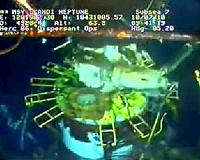 |
New Orleans, Louisiana (AFP) July 12, 2010 As BP worked to finally cap a ruptured well gushing oil into the Gulf of Mexico Monday, the task of assessing what went wrong and what needs to be done to prevent another disaster began. In its first public hearing, members of a presidential commission spent hours questioning panelist after panelist about the effectiveness of the response, the impact on coastal communities and businesses and the safety standards and practices of the offshore oil industry. But the most poignant moments came when the microphones were turned over to the public. "I'm going to lose my house," said Cherri Foytlin, a mother of six whose husband lost his job in the oil industry after a moratorium was imposed on deepwater offshore drilling. "Whatever you do, whatever you decide, please take into account that you are talking about people," she begged as tear filled her eyes. "You are not talking about numbers and politics, you are talking about my family. My whole big Louisiana family." Crawfish fisherman Drew Landry said he was worried that the next big storm surge could sweep the oil deep into the bayous and contaminate people's homes and yards. "This could be the next expulsion of the Cajun people, people that love this place," Landry said after pulling his guitar out and singing about how his "way of life won't be no more." An estimated 2.1 to 4.1 million barrels of oil has gushed into the sea since the BP-leased Deepwater Horizon sank spectacularly on April 22, two days after a deadly explosion. Oil has washed up on beaches in all five Gulf states -- Texas, Louisiana, Mississippi, Alabama and Florida -- closing fishing grounds and threatening scores of coastal communities with financial ruin. "I wish that we had the power to bring immediate solutions to stop the oil," former senator Bob Graham, who co-chairs the seven-member commission, said as he opened the hearing. "We do promise to give our very best efforts to find out what is happening and the enormous consequences of this spill on the lives and the livelihood and the culture of the Gulf region." The independent commission is tasked with investigating the causes of the spill and the effectiveness of the response and making recommendations on ways to prevent future spills and better regulate the offshore oil industry. While BP successfully placed a new cap over the ruptured well late Monday, up to two days of testing were needed to determine whether it can safely contain the gusher. A permanent solution is expected in August when the first of two drilling wells is completed. "Capping that well will give us an end," Coast Guard Rear Admiral Peter Neffenger, the deputy incident commander, told the commission. But with so much oil already in the Gulf, the cleanup and recovery operations are going to go on for quite some time, he said. "I don't know that I can put an outer bound on it." Many of the people testifying urged the commission to recommend lifting the moratorium on deepwater drilling, including Senator Mary Landrieu who said it could lead to the loss of 120,000 jobs in Louisiana alone and a "second economic disaster that has the potential to become greater than the first." Commission co-chair William Reilly said he could understand why the industry and local officials would rather replace the blanket freeze with a process that would simply impose greater scrutiny and grant approval on a case-by-case basis. "Before we can recommend lifting the moratorium one would have to have a conviction that the kinds of concerns it intended to address have been met," Reilly said. "It doesn't seem to me that we're in that position."
Share This Article With Planet Earth
Related Links Powering The World in the 21st Century at Energy-Daily.com
 BP fixes new cap to finally stem Gulf oil disaster
BP fixes new cap to finally stem Gulf oil disasterNew Orleans, Louisiana (AFP) July 12, 2010 BP placed Monday a new cap over the ruptured oil pipe in the Gulf of Mexico, hoping to stem the catastrophic flow of toxic crude once and for all. Almost 13 weeks after America's worst environmental disaster began with a deadly explosion on the Deepwater Horizon rig, the end is finally in sight as engineers lower a device called the "Top Hat 10" from a surface ship. As of 2000 GMT, the g ... read more |
|
| The content herein, unless otherwise known to be public domain, are Copyright 1995-2010 - SpaceDaily. AFP and UPI Wire Stories are copyright Agence France-Presse and United Press International. ESA Portal Reports are copyright European Space Agency. All NASA sourced material is public domain. Additional copyrights may apply in whole or part to other bona fide parties. Advertising does not imply endorsement,agreement or approval of any opinions, statements or information provided by SpaceDaily on any Web page published or hosted by SpaceDaily. Privacy Statement |